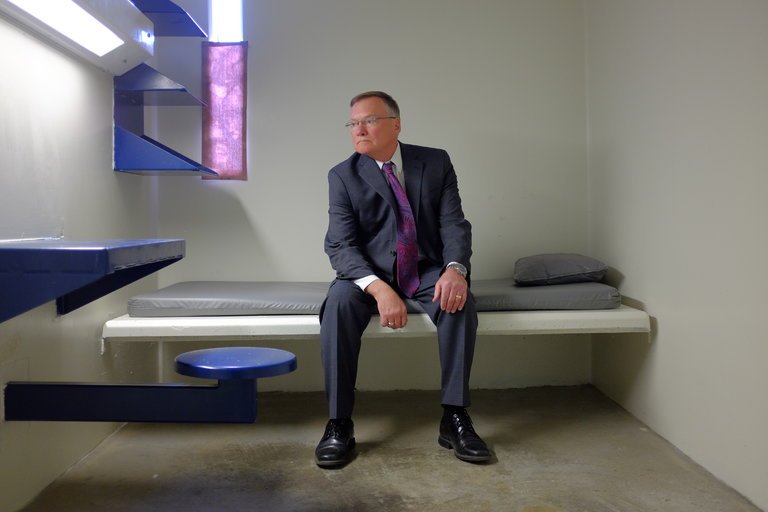Ripple Effects of Raemisch's Decision to End Long Term Solitary in CO Prisons Felt Far & Wide
Maybe It Will Be Felt In CO Jails
|
WISC -- NEWS 3 Madison, Wisconsin
"Last Friday, former Dane County Sheriff Rick Raemisch wrote an op-ed piece in the New York Times about Colorado’s success in eliminating long-term solitary confinement in the state’s prisons, which Raemisch now oversees as executive director of the Colorado Department of Corrections. "Coincidentally on that same day the WISC editorial board toured the Dane County Jail and saw first-hand solitary confinement cells that are antiquated, unsafe and inhumane. "We need a little time to absorb all of the details of the proposed $76 million jail renovation proposal, but the elimination of solitary confinement cells and the addition of medical and mental health beds is something we support unequivocally. "Yes, it’s a jail. But no-one should come out of jail in worse shape than they went in, and that’s happening now. "New jail infrastructure is badly needed. But ultimately we need the kinds of policy reforms Raemisch has made in Colorado. "Long term solitary confinement is ineffective, unnecessary and worst of all inhumane. Raemisch and Dane County Sheriff Dave Mahoney have proof." http://www.channel3000.com/news/opinion/jails-solitary-confinement-cells-are-antiquated-unsafe-inhumane/638756384 |
Welcoming the End of Long-Term Solitary Confinement in CO Prisons & Next Steps
|
Colorado's decision to follow the United Nations "Mandela Rules" when it comes to Solitary Confinement in prisons could not be more welcome.
Primarily that means recognizing that Solitary Confinement for more than 15 days amounts to Torture for anybody, whether they have a recognized disability or not. Of course, we don't want to see anyone in Solitary and there is just a real problem of dividing this along disability lines when our understandings are not as great as they could be. Prior to reading the Opinion piece by CO DOC Head Rick Raemisch, we were unaware that Raemisch had participated in the development of the "Mandela Rules." Reading between the lines, it appears that Raemisch's thinking has evolved on this. We think it is really important for people in power and really all of us to acknowledge "evolutions in thought" -- which we have -- whether we're Raemisch, or Obama, or whoever. Sometimes it is getting new, undiscovered information -- sometimes it's just looking at what we've already got from a different perspective or many different perspectives. We have been critical of DOC for some "lapses" BUT there is nothing like raising the Moral Bar to make that less relevant. In Islam allegedly, and we're not Islamic scholars, it should be a competition for Good Works. Next stop: ending solitary lasting longer than 15 days in Colorado Jails, and banning it for people with disabilities. Maybe an Olmstead Planning Bill could help with that. |
New York Times
By Rick Raemisch Why We Ended Long-Term Solitary Confinement in Colorado https://www.nytimes.com/2017/10/12/opinion/solitary-confinement-colorado-prison.html Excerpt: Then, in 2015 I assisted the State Department with other United Nations countries in modernizing international standards for the treatment of prisoners, now known as the Nelson Mandela Rules. During the debates about the wording of the new standards, it was decided that keeping someone for more than 15 days in solitary was torture. After listening and being involved in those discussions, I agreed. There now is enough data to convince me that long-term isolation manufactures and aggravates mental illness. It has not solved any problems; at best it has maintained them. That’s why, in September, Colorado ended the practice. Inmates who commit serious violations like assault will now spend at most 15 days in solitary, and, if necessary, undergo therapy or anger management classes afterward. Today, there are only 18 inmates in such segregation, and we deal with minor offenses like mouthing off in less severe ways. These reforms are unique to Colorado. It’s estimated that, around the country, more than 80,000 prisoners at any given time are held in isolated confinement. Long-term solitary was supposed to be rehabilitative, but it did not have that effect. Studies have found that inmates who have spent time in solitary confinement are more likely to re-offend than those who have not. Data shows that prisoners in solitary account for about half of all prison suicides; self-harm is also more common in solitary units than in less-restrictive ones. One social psychologist even found that the degree of loneliness experienced by people in solitary is matched only by that of terminal cancer patients. In addition, solitary confinement was intended to be a last resort for those who were too violent to be in a prison’s general population. But then we gradually included inmates who disrupted the efficient running of an institution. In other words, inmates could be placed in solitary for almost any reason, and they were. But this transformation created consequences we didn’t foresee. My predecessor, Tom Clements, was assassinated in 2013 by a former inmate who had been released directly into the community after having spent seven years in solitary. Mr. Clements had worked to reform Colorado’s overuse of solitary when he was murdered by the kind of person he was trying to help. Gov. John Hickenlooper hired me to continue Mr. Clements’s work. Just six years ago, 1,500 inmates, or almost 7 percent of the prison population, were housed in solitary on any given day. When I arrived in 2013, there were still over 700 inmates in solitary, some of whom had been there for years. Approximately half of them were still being released directly into the community without being reintegrated. Now inmates are no longer placed in long-term isolation, nor are any inmates released directly from solitary. My staff relayed stories to me that were simply unbelievable. I was told of instances where two corrections officers would remove an inmate from solitary after years of involuntary isolation. Then they would place him on a city bus, remove the cuffs and shackles from his arms and legs, and leave him on his own. How did we ever accept this as good practice? Would you want to live next to one of those former inmates? I surely wouldn’t. I became convinced this practice was a contradiction of our mission of public safety and felt even more so after I spent 20 hours in solitary confinement myself. Experiencing solitary firsthand, I thought, would better position me to change our culture. If I was troubled by the experience after such a relatively short time, then I had to say, “Enough.” Not everyone agreed with my new policy. But the corrections officers who had initially opposed it changed their minds after they began to see positive results. I’ve seen and been told that the corrections officers are interacting with the inmates in a more positive manner. It is time for this unethical tool to be removed from the penal toolbox. Colorado has ended long-term solitary because the state has developed alternatives to its use. We have done this not only to fulfill Mr. Clements’s vision, but also because since over 95 percent of all inmates eventually leave prison, it is simply the right thing to do — for the inmates and for their communities. |

